

Archive for October, 2020
STAR TREK Modeling: A Brief History of the Shuttlecraft Galileo Pt. 5
Thank for returning for this final chapter in Round 2 consultant, Gary Kerr’s, history on the Galileo shuttle.
A Brief History of the Shuttlecraft Galileo Pt. 5 By Gary Kerr
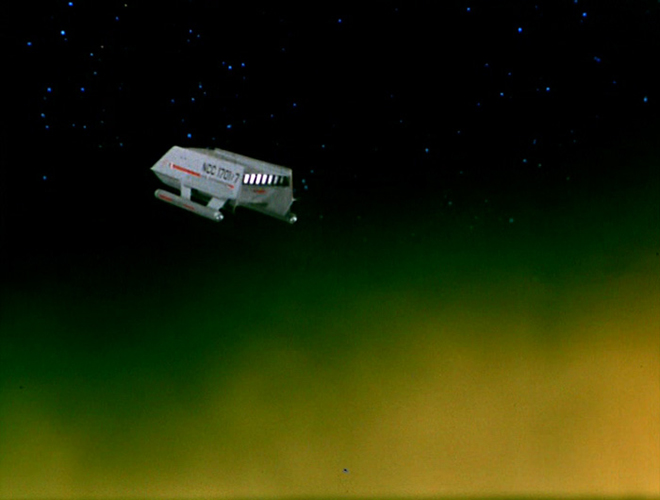
Rescue and Rebirth
The whereabouts of the Galileo were unknown, and fans despaired that it had been scrapped, but the plucky shuttlecraft resurfaced in 2012, when Kiko Auctioneers held an 11-day online auction. The auction price was holding at around $20,000, but on June 28, 2012, the bidding came to a head when three bidders jumped in during the last 90 seconds of the auction. Adam Schneider, a collector of numerous Star Trek studio miniatures, placed the winning bid of $70,150.00, and the Galileo became by far the largest spaceship model in his collection.
Since the Galileo was far too large to display at Adam’s home in New Jersey, Adam’s goal was to completely restore the rotting prop and donate it to a museum for public display. Gene Winfield, who had originally built the Galileo, suggested that a builder of wooden boats might be best suited for the job, and Adam selected Master Shipwrights Design and Restoration, which specialized in restoring antique and classic boats, to do the restoration. The Galileo was trucked to Master Shipwrights in Atlantic Highlands, NJ, but six days later, on October 29, 2012, disaster struck, as Hurricane Sandy slammed into the East Coast. In anticipation of a storm surge, the mock-up’s nacelles were placed in a high and dry location, while the mock-up, itself, sat on 12” blocks. Sandy’s storm surge flooded Master Shipwrights’ shop with four feet of water, but the Galileo survived. As Adam said, the mock-up was already such a hunk of junk that the floodwater couldn’t hurt it any further.
Over the next two months, the shop’s employees de-salted the shop and the mock-up, and then they went to work on the Galileo.
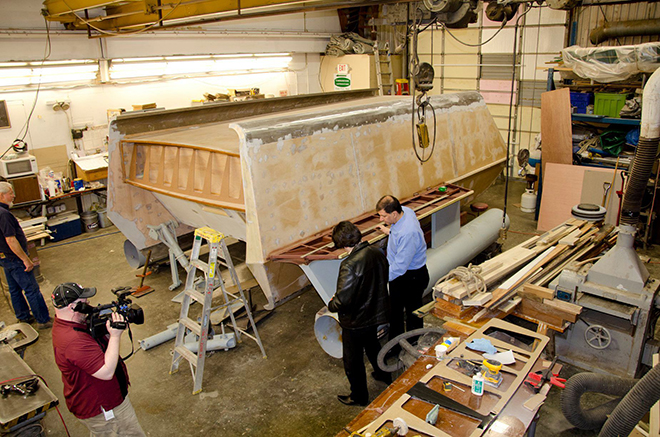
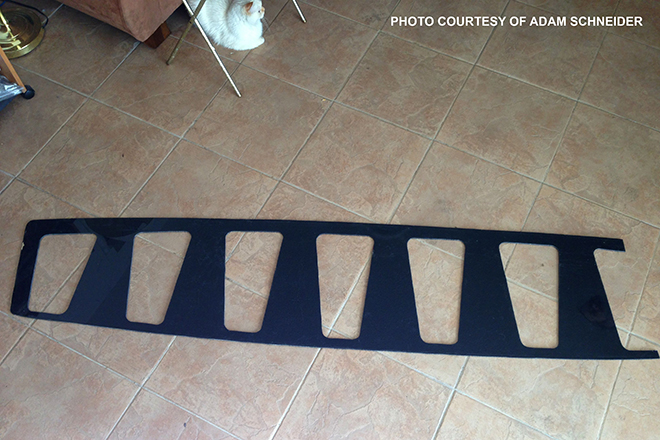
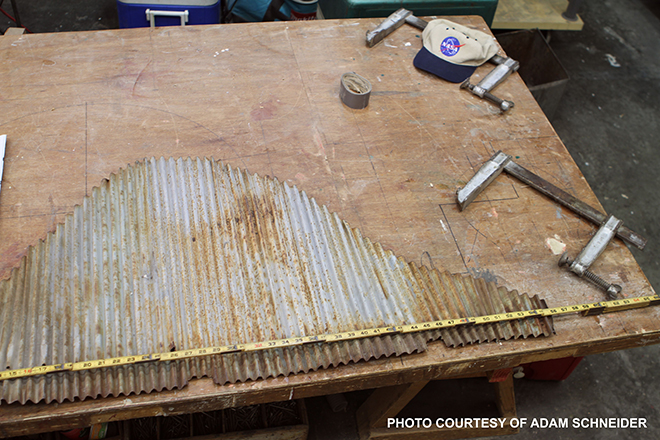
After they straightened and repaired the ship’s internal metal skeleton, they replaced the rotted framing with all-new wood. Lift points were added so the heavy mock-up could be moved safely. Sturdy Marine-grade plywood replaced the flimsy Masonite, and the finished shuttle was painted with marine-grade paint. I supplied artwork for the external markings, plus additional information, and Will Smith built a replacement “busy box”, a collection of gizmos hidden behind a fold-down panel on the aft end of the shuttle, which Spock and Scotty would work on every time the shuttle got stranded on an alien world.
Once the Galileo was fully restored, Adam set about finding a suitable museum to house the ship. Display space, especially for an artifact as large as the Galileo, is at a premium in most museums, and after contacting over a dozen museums, Adam settled on NASA‘s Space Center Houston, which is part of the Johnson Space Center. The Galileo was unveiled, amid much ceremony, on July 31, 2013.
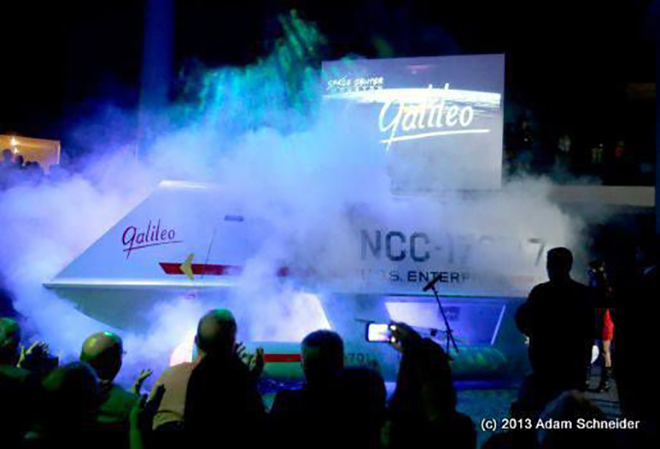
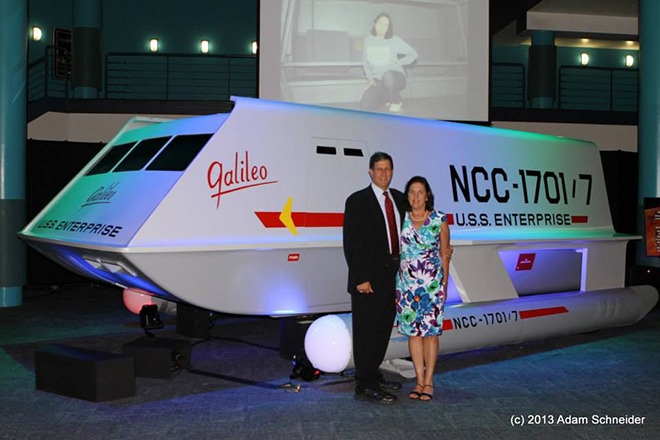
In 2016, the Galileo was loaned to the Intrepid Sea, Air & Space Museum in New York City, and upon its return to Houston, the shuttle was ignominiously displayed in a corner of the museum’s cafeteria.
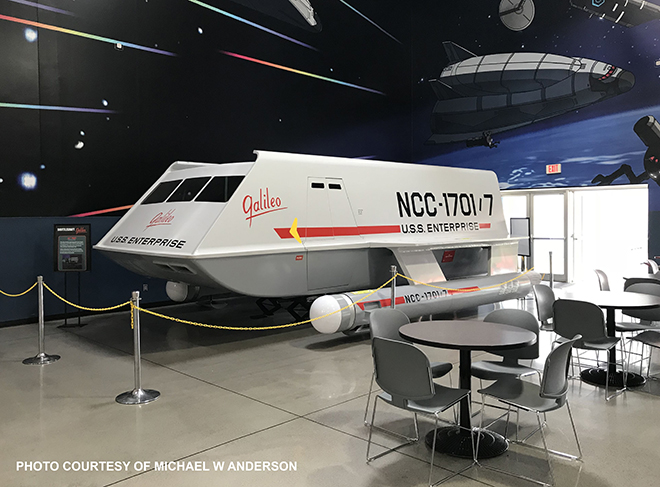
The current management team at the museum is apparently not a fan of Star Trek. The Galileo has been removed from public display and put into storage because it does not fit into management’s “vision” for the museum.
The Filming Miniature
In contrast to its widely-traveled big brother, the 22-inch Galileo miniature was a relative shut-in and remained in the Los Angeles area for most of its existence. The model, constructed mainly from wood and plastic, was designed to be filmed either suspended from wires, or mounted on a post inserted into the model’s belly. The studio model also had internal lighting for its impulse deck and front windows. Richard Datin had decal sheets with markings for both the Galileo and Columbus, but only the Galileo markings were ever applied to the model.
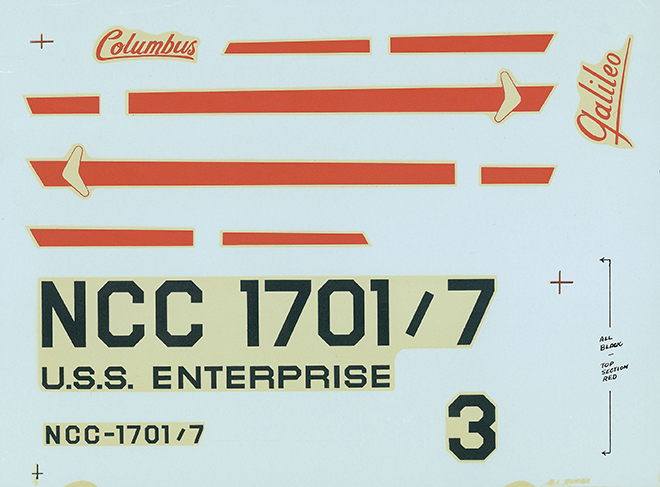
One of the model’s features has been overlooked until recently. In 2019, Star Trek authority, Doug Drexler, and aerospace historian and writer, Glen Swanson, had been sleuthing through the archives at UCLA and AMPAS (Academy of Motion Picture Arts and Sciences). Doug and Glen hit pay dirt, we were able to use Doug’s Academy Award winner discount to get 600 dpi scans of previously unreleased photographs (not grainy film clips) of the studio model of the Enterprise, plus shots of the newly built Galileo miniature before it was fully detailed. The model, suspended from overhead wires, had a glossy, 2-tone paint scheme, and apparently to serve as Commodore Mendez’s shuttle in “The Menagerie, Pt 1”, somebody had plastered “173” in large letters on the model’s side. Richard Datin worked on the model for several hours on October 31, 1966, and this may have been when the Galileo’s official markings were applied.
The most important discovery lay on the model’s wooden roof: the existence of scribed panels. They were very similar to the panels on the concept illustration that Thomas Kellogg had drawn for Gene Winfield and Matt Jefferies in 1966, when an affordable version of the Galileo was first being designed.
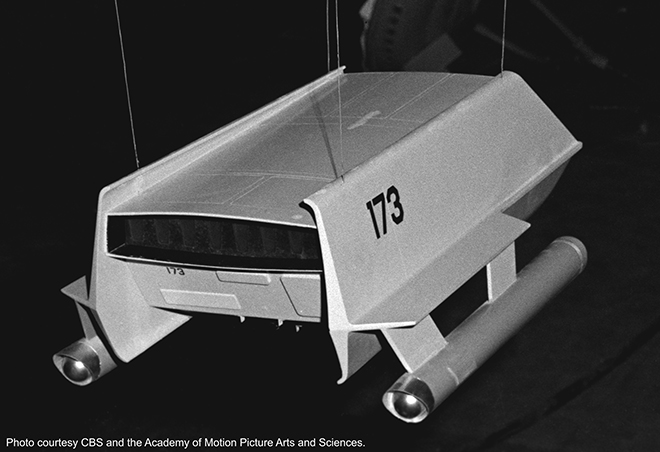
The 22-foot mock-up did not possess corresponding roof panels, which makes financial sense. Because the roof of the mock-up was seen only one time in the series, in a wide establishing shot in “The Galileo Seven”, it seems reasonable did not want to waste their budget dollars on full-size panels.
The model vanished after the series ended, and was presumed to be lost, stolen, or destroyed during a cleanup at Paramount in 1973. In 1987, though, the Galileo model unexpectedly reappeared. As long-time scenic art supervisor and Trek historian, Michael Okuda, explained, Set Decorator John Dwyer found the shuttlecraft miniature in storage at Paramount. He brought it up to the Art Department, plopped it onto Mike’s desk, and asked, “Do you know what this is?”
The Galileo was in pretty poor shape. The entire front bulkhead (the panel with the windows) was missing, and overall surface was cracked pretty badly. The nacelles, themselves, were broken off, and the corrugated cowlings on the ends of the nacelles were missing.
Dwyer took the model down to the effects shop to have it refurbished. They did a decent job, considering that they were undoubtedly rushed, and probably didn’t have any reference to work from, except the prop itself. The most significant error that they made was that the front panel, instead of being replaced with a new solid piece with three windows, was replaced with a single piece of dark Plexiglas “window”. The model also lost its 2-tone paint scheme.
Dwyer used the model as set dressing in Riker’s quarters in the 7th episode of the first season of Star Trek: The Next Generation, “Lonely Among Us“, which was filmed from August 26-September 3, 1987.
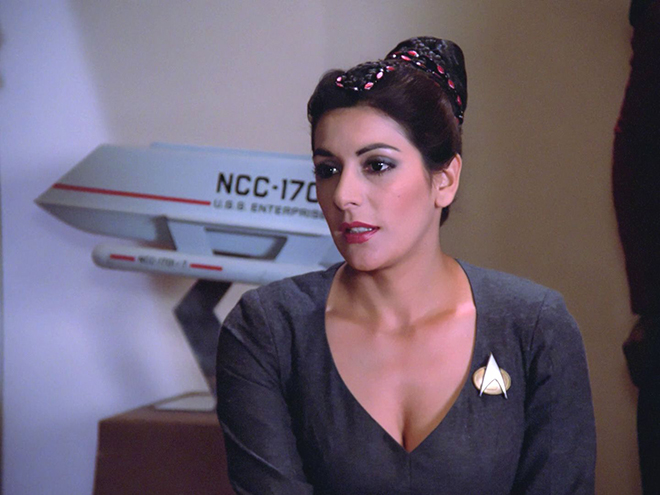
Early the following year, master model maker Greg Jein, who had begun to refurbish the model, loaned it to the local “Equicon ’88 Science Fiction Convention“, where it was on display from April 1-3, 1988.
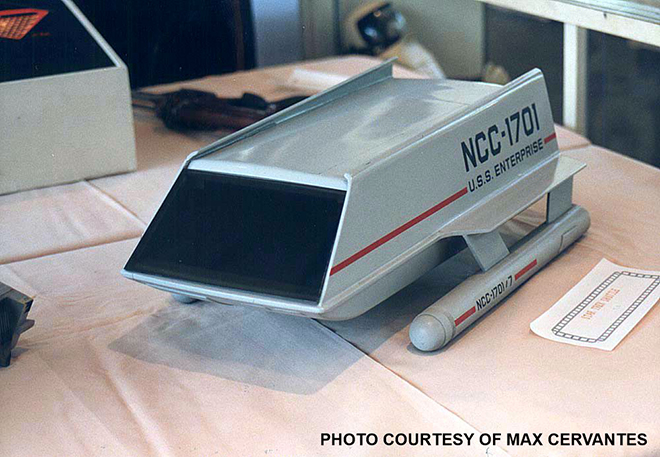
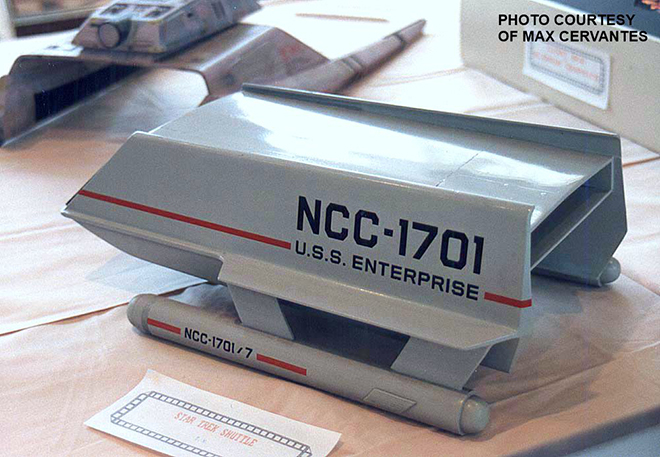
Afterwards, Greg Jein finished restoring the model to its original appearance, sans landing gear. Greg noted that before he restored the model, you could see straight through it, from front to back. During the restoration, Greg gave the model something that it had never had, a dash between the large “NCC” and “1701” on the side of the ship. The dash had accidentally been omitted from the 1966 decal sheet, and a quarter-century later, that oversight was remedied.
In 1992, Paramount loaned the Galileo model to the Smithsonian for their 1992-93 Star Trek exhibition.
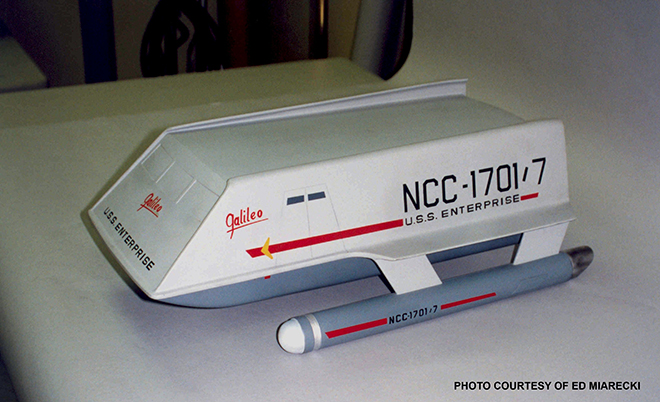
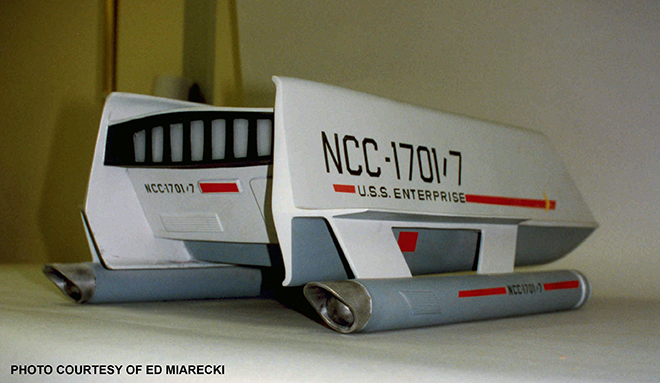
The model’s last public appearance was in 1993-94 at an exhibition at the Hayden Planetarium in New York City.
Epilog
Against all odds, both of the original Galileos have survived over 50 years of rain, sun, floods, crushing, and neglect. With any luck, they’ll be around for many more years to come.
Thank you, Gary, for all of the work you put into this special blog series. Until next time, live long and prosper!
All images courtesy of CBS, except where noted.
TM & (C) 2020 CBS Studios Inc. ARR.
STAR TREK Modeling: A Brief History of the Shuttlecraft Galileo Pt. 4
The story of the Galileo shuttle by Round 2 consultant, Gary Kerr, continues…
A Brief History of the Shuttlecraft Galileo Pt. 4 By Gary Kerr
Turning Back the Clock
The Galileo mock-up sported a glossy, 2-tone exterior color scheme – lighter gray above and darker gray below – but the exact shades of gray were thought to be lost to time since the original paint had faded after decades of exposure to the elements. In 2015, I’d made a color match for the weathered light gray paint that was on a fragment of the Galileo owned by Adam Schneider (more on him later). I also had a sample of the weathered darker gray from the lower half of the mock-up. I now had samples of the original light and dark gray paint, but I had no way of knowing how much the original paints had faded.
The situation changed when I acquired the original window shutter for the Galileo’s “driver’s side” front window. The shutter is a low-tech affair: a beat-up piece of Masonite with a wooden frame in back.
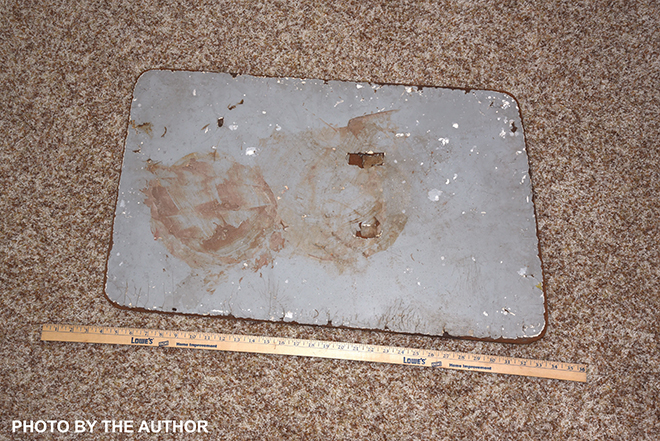
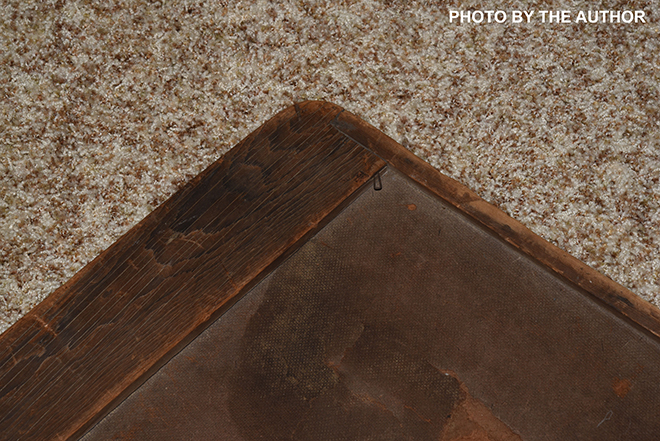
The shutter did not slide up and down, but was simply placed into the window opening on the shuttle. There were a number of spots where three layers of paint were exposed: a white primer base coat, a light gray middle layer, and a darker gray top coat. The top coat had almost certainly been applied by Trek fans during a restoration, but the middle layer was an exact match for the weathered light gray that I had examined in 2015. I wanted to expose more of the light gray middle layer, so I began to carefully chip away the brittle top layer of paint with an X-Acto blade. To my surprise, the freshly exposed paint, which had been protected from the sun by the fan-applied paint, was a couple shades darker than Adam Schneider’s sample. The paint was a good match for Pratt & Lambert’s “Half-tone”, which the Smithsonian’s paint expert, Dave Wilson, had identified in 2016 as the color of the gray trim under the front ends of the nacelles on the 11-foot original Enterprise model. Very interesting…
I now had samples of the weathered light and dark gray paints, plus the relatively unweathered light gray paint from the shutter. If the original light gray paint had faded by X amount over the years, could I arrive at an approximation of the original dark gray paint by darkening my faded dark gray sample by X amount?
I had the paint store do a color match on my weathered dark gray sample, and then darken the paint by a couple shades. My recreation of the unweathered dark gray was a good match for Pratt & Lambert’s “Gettysburg”, which the Smithsonian’s Dave Wilson, had matched to the color of the impulse deck and inboard nacelle trenches on the 11-foot Enterprise. My conclusion: it appears that that Matt Jefferies had selected two shades of gray trim from the Enterprise for use on the Galileo’s outer hull.
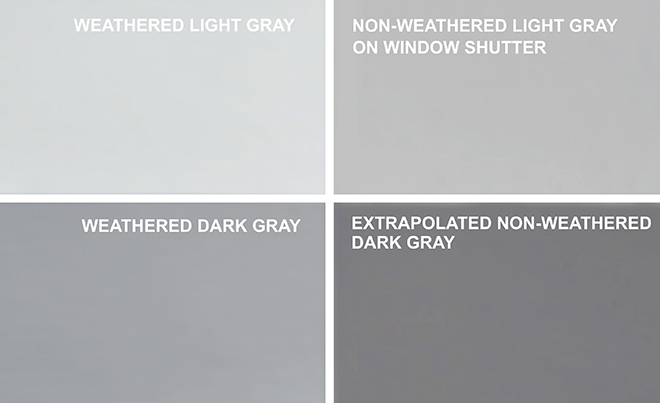
The Galileo mock-up first appeared before the cameras for “The Galileo Seven” on September 27, 1966. Two weeks later, October 12, 1966, the Galileo portrayed an anonymous shuttlecraft from Starbase 11 in “The Menagerie, Part 1”. Even though “The Galileo Seven” was filmed first, the episode was delayed, presumably by the wait for the hangar bay miniature to be built and filmed, and wasn’t aired until January 5, 1967. Thus, the Galileo’s first onscreen appearance occurred on November 17, 1966, in “The Menagerie, Part 1”.
During the run of the series, the full-size exterior and/or interior props also made appearances in “Metamorphosis”, “The Doomsday Machine“, “Journey to Babel“, and “The Immunity Syndrome“, with its farewell performance in “The Way to Eden”.
Life After Star Trek
After the original series ended, the Galileo began a years-long, cross-country odyssey. Paramount donated the 22-foot Galileo mock-up to The Braille Institute in Los Angeles. The Masonite, plywood, and metal prop was not designed to withstand the elements, and once outdoors, it began to deteriorate. Because of safety concerns, the institute sold the prop to Roger Hiseman of Palos Verdes, who displayed the decomposing shuttlecraft, a photo op for young Trek fans, in his front yard. Following complaints from his neighbors, the Galileo was moved to an open storage area in Redondo Beach.
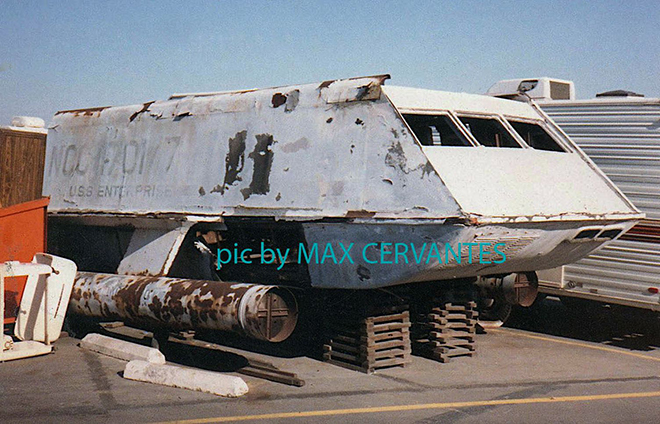
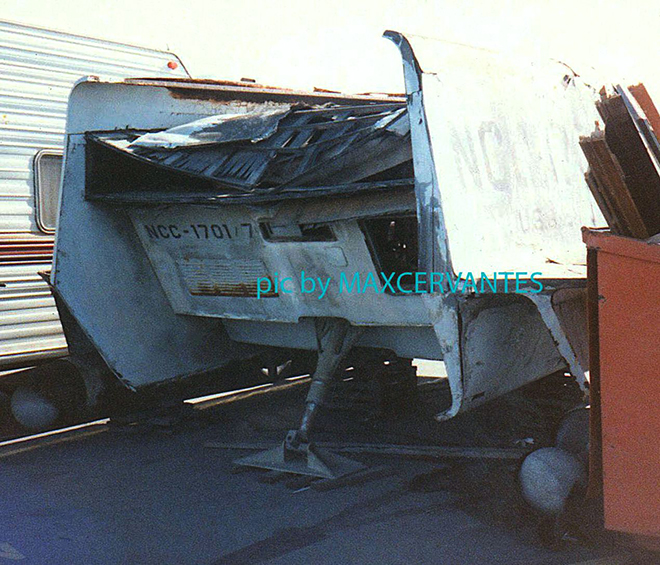
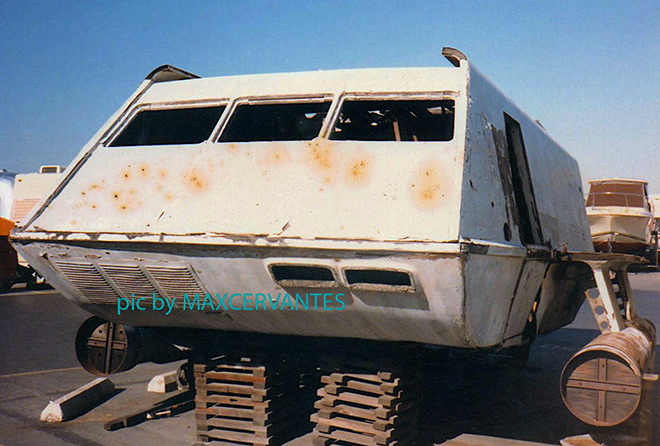
By this time, the mock-up was looking MUCH worse for the wear, and the roof over the impulse deck had collapsed. The Galileo changed hands again in 1985 and ended up further south, to another open storage area near San Diego, where the mock-up’s owner attempted a restoration. Following an appearance at a 1986 Star Trek convention in Anaheim, the mock-up was moved to yet another open storage area, this time near Palm Springs, and the semi-restored mock-up continued to deteriorate.
In 1989, a Star Trek fan in Ohio, Lynne Miller, purchased the mock-up for $3,000 and had it shipped over to the Canton/Akron airport in April 1991. After many years, the mock-up finally had a roof over its head. Yet another restoration was begun, and the Galileo was displayed at a Trek convention near Cleveland the following November.
As mentioned previously, in April 1992, on the way home from visiting the hugely popular Star Trek: The Exhibit at the National Air and Space Museum in Washington DC, a couple friends and I rendezvoused with Lynne Miller at the Canton/Akron airport and spent several hours documenting the mock-up. I took home a couple souvenirs, including an 8 ft roof truss, from a pile of rotting wood that had been removed from the mock-up.
The restoration stopped in 1993, following a dispute between Ms Miller and those doing the restoration. The Galileo had to be moved yet again when the airport property was sold and the hangar was demolished, and it ended up in open storage at an industrial site near Akron. The mock-up dropped out of sight when the property was sold and cleaned up in 2008.
What a shocking turn of events! The Galileo straight up disappeared! Find out what happened next in the Earth-shattering conclusion to Gary’s story.
All images courtesy of CBS, except where noted.
TM & (C) 2020 CBS Studios Inc. ARR.
STAR TREK Modeling: A Brief History of the Shuttlecraft Galileo Pt. 3
Welcome back for our continuing series of Galileo articles by Round 2 consultant Gary Kerr.
A Brief History of the Shuttlecraft Galileo Pt.3 By Gary Kerr
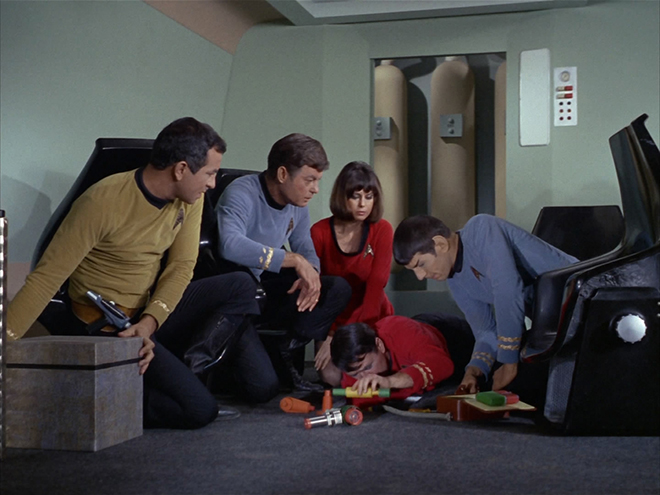
The Inside Job
The set representing the Galileo’s interior was constructed simultaneously with the exterior mock-up. To facilitate filming with the large, bulky movie cameras, the walls and front bulkhead were ‘wild’; that is, they could be rolled out of the way, as required, for filming various camera angles. In a major deviation from an interior that would actually fit inside the shuttlecraft, the ceiling was raised so the actors could stand erect without bumping their heads on the ceiling. An overhead light panel ran the length of the passenger compartment, and the plastic grid inside the panel’s frame could be removed to allow the use of overhead studio lights.
The flight controls and computers were rudimentary, and were primarily designed to give the impression of high-tech instrumentation, with actors being the center of attention. To save money, the “computer” props were reused as set dressing in other episodes of the show. I’m quite sure that nobody involved in the production had the foggiest idea that anybody would be examining their work, frame-by-frame and in high def over a half century later.
The aft compartment was something else altogether, since it changed size and shape in every scene. For example, in “The Galileo Seven”, there’s a dramatic close-up as the crew members watch Scotty drain a phaser to recharge the ship’s power. The yellowish tanks in the aft compartment are artfully framed just inside the rear doorway. But when Scotty goes in back to shock the ape monsters that are threatening them, the aft compartment has at least quadrupled in size, and the yellow tanks are nowhere in sight.
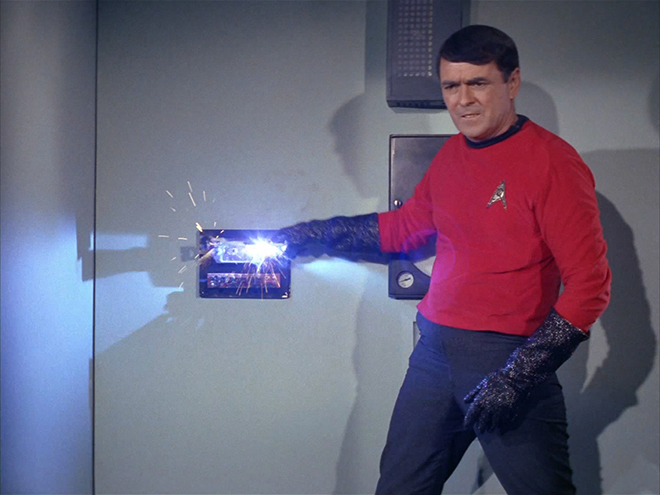
The audience didn’t realize it at the time, but we got a sneak-peek at the tanks before they were installed in the Galileo when they were turned upside-down to serve as phaser coolant tanks in “Balance of Terror”.
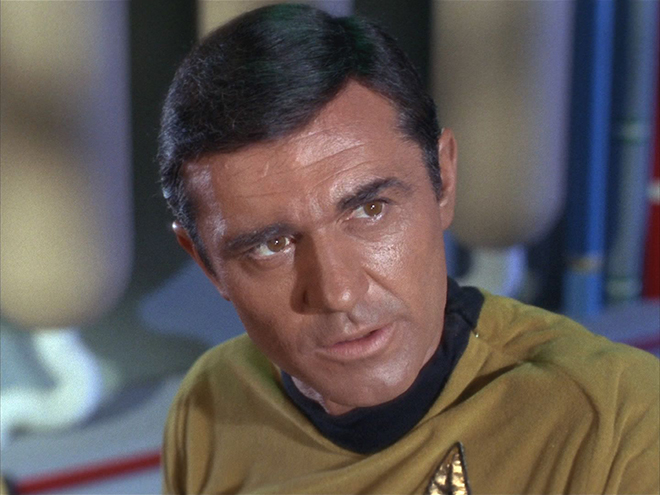
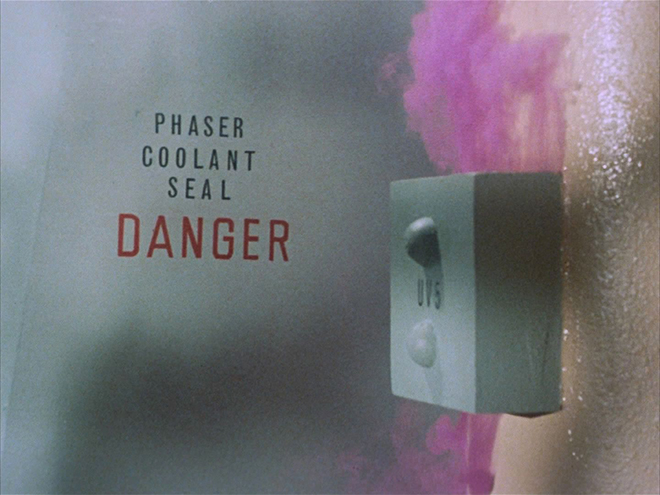
The starboard wall had several gizmos affixed to it, including an instrument that looks somewhat like a wall clock. In real life, it was a repurposed Honeywell chart recorder, with the name “Honeywell” covered over.
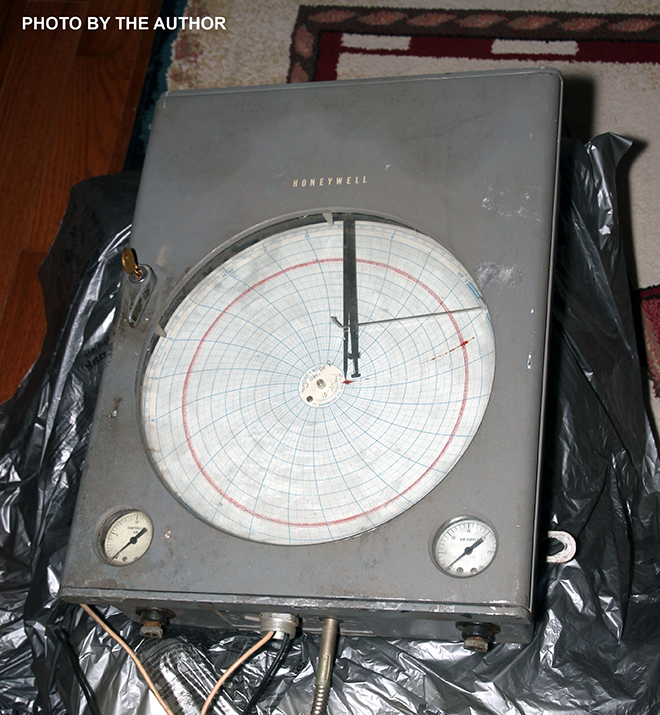
It appears that there was no port wall, wild or otherwise, in the aft compartment. In fact, if you carefully examine the scene in “The Galileo Seven” in which the camera shakes while the monsters attack the shuttle, you can actually see the soundstage for a split-second where the left wall should be.
On August 15, 1966, Jefferies flew out to the Phoenix shop for a quick, one-day inspection, leaving LA on Continental Airlines flight #68, and returning on Western Airlines flight #624. Total cost: $54.29. Those were the days!
With the mock-up and miniature Galileo under construction, the production needed a hangar bay to park the shuttle in. Richard Datin, who had built the 3 ft Enterprise model and supervised construction of the 11-footer, built the miniature hangar bay set in his garage workshop at 4146 Klump Ave, in North Hollywood, near Studio City, California. Datin began construction on Sept 14, 1966, and completed the project on Oct 25, 1966. Constructed with pine framing, Masonite floor & walls, and Plexiglas ceiling & windows, the 1/12 scale model was 122” long. The forward end of the model was 76” wide and 38” high, while the aft end was 60” wide and 29” high. Total cost of the model: $2138.00.
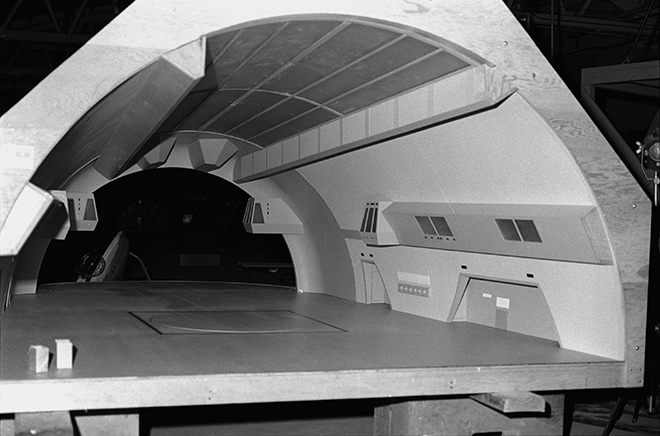
Once Winfield’s shop had finished their part of building the interior & exterior props, along with the 22” miniature, the unfinished components were trucked to the studio in LA, where union craftsmen did the final painting and detailing, and added electronics to the interior set.
Next time, Gary takes a look at the filming miniature and paint colors. See you then!
All images courtesy of CBS, except where noted.
TM & (C) 2020 CBS Studios Inc. ARR.
